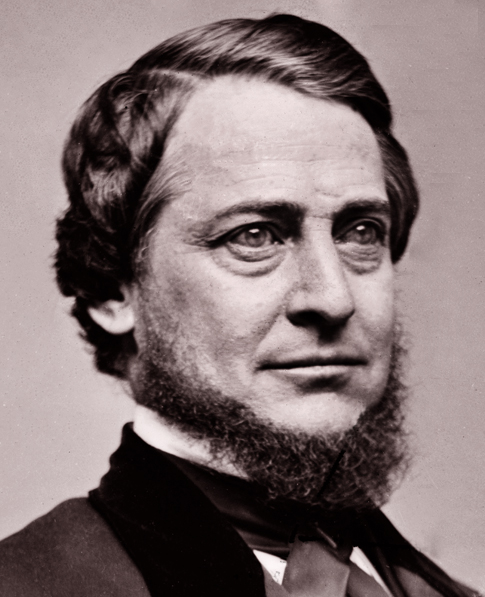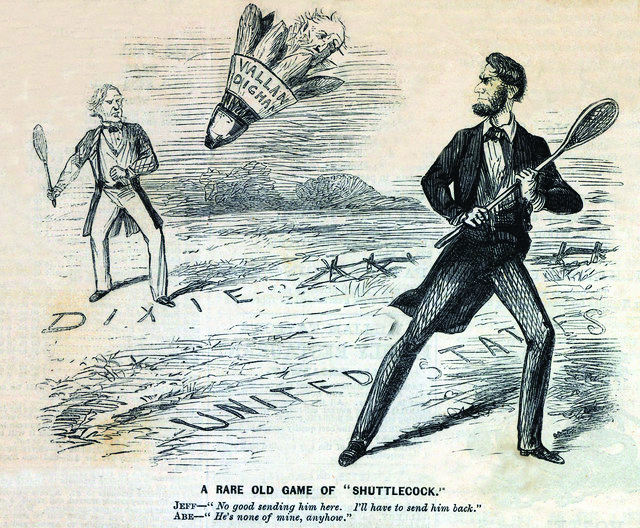 If a naturalist of the 19th century were to seek the biggest specimen of north american gadfly, his search would have ended with Clement Vallandigham. A staunch opponent to Emancipation of enslaved Africans, and open critic of the Lincoln administration, he managed to garner direct attention from Lincoln himself. It is stunning to comprehend that the President, while bearing the weight of national administration during the conflict, would be so consumed with Vallandigham, that he had him banished to the Confederacy. Vallandigham had proven to be such an all around pain in the ass, that the Confederates didn't want him either. It is funny to consider, when two adversaries, strapped for resources and seeking to harm the other in whatever means possible, both found that the most destructive thing that they could do, was push him into the opponents lap. Seamingly drawing the short straw, the Confederates were stuck with him, and after briefly being imprisoned, shipped him off to Canada.
If a naturalist of the 19th century were to seek the biggest specimen of north american gadfly, his search would have ended with Clement Vallandigham. A staunch opponent to Emancipation of enslaved Africans, and open critic of the Lincoln administration, he managed to garner direct attention from Lincoln himself. It is stunning to comprehend that the President, while bearing the weight of national administration during the conflict, would be so consumed with Vallandigham, that he had him banished to the Confederacy. Vallandigham had proven to be such an all around pain in the ass, that the Confederates didn't want him either. It is funny to consider, when two adversaries, strapped for resources and seeking to harm the other in whatever means possible, both found that the most destructive thing that they could do, was push him into the opponents lap. Seamingly drawing the short straw, the Confederates were stuck with him, and after briefly being imprisoned, shipped him off to Canada.

It was this voyage that is of particular interest to students of material culture, as it was not so much the trip, but the vehicle. He sailed in none other than the Harriet Pickney, which was one of the blockade runners owned by Isaac & Campbell. While it may have been a matter of convenience, Vallandigham's very presence may have been a deterrent to Union boarding parties, because the last thing that they wanted to do, if captured, was bring him back north. Transporting the subversive Vallandigham, who Lincoln called a "wily agitator", represented a monumental risk to isaac & Campbell, giving up all pretense and positively removing any veil of political neutrality.

Vallandigham continued to be an annoyance until war's end. After the war, he maintained his antipathy towards civil rights and suffrage of african americans, and then abruptly reversed himself. Defeats in the political arena sent him back to practice law. In what would be his final case, he was defending a man who was accused of murder, for shooting a man in the stomach during a bar fight. His defense was that the victim had accidentally shot himself, and although a tragedy, it was little more than a stupid mistake. He intended to prove this by reenacting the bar fight in front of the jury, showing them how easily this could have occurred.
Vallandigham accurately recreated all aspects of the bar fight, right down to the stupid part, shooting HIMSELF in the stomach. His client was acquitted, but Vallandigham died the next day.
Academics tend to choose the written word over the surviving artifact, and consequently hold living historians at arm's length. This is but one example of the puzzle pieces of written history piec together, which were initially inspired by artifacts studied for the purpose of living history. For living historians, it should not be about who makes the kewlest reproduction of that artifact hanging in your closet. It is a tangible object with a back story rich in political intrigue. Both perspectives are resolute that the grass is greener on their side of the fence. I would assert that there should be no fence.
#livinghistory #fashionhistory #historicfashion #historiccostuming #1860s #victorianfashion #costumehistory #civilwar #louisdevere #periodcostume #civilwarrelics #mensfashion #mensfashionhistory #civilwarsoldier #civilwarreenacting #gettysburg #19thcenturylife #louisdevere @FIT #fashioninstituteoftechnology #historicalinspiration #historicalsewing #periodbaseball #vintagebaseball #19thcenturybaseball #baseballhistory